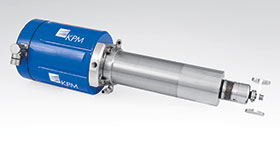

In pulp and paper manufacturing, hot stock consistency measurement is one of the most difficult applications.
Hot stock refining, without managing consistency, creates stock that varies in freeness and is poorly developed for papermaking. Non-uniform stock and wasted energy results in high-cost fibre development, which then makes using the fibre a challenge. This non-uniform stock does not provide the opportunity to maximise the performance of the pulp and papermaking equipment and operations.
For years, the only way to measure consistency prior to the refiners was to monitor the drive-motor current from the scrapers or agitators. This is not a precise consistency measurement, but it was used in many mills to calculate production for the refiner control strategy. This consistency measurement produced results that varied considerably and proved inadequate for good refiner control.
In hot stock refining, managing HPD/T provides improved fibre characteristics, predictable freeness drop across the refiner, and more uniform stock. The specific energy transferred from the motor to the fibre needs to be applied at a target consistency to maintain refiner stability and thus develop the desired stock properties.
The washers that follow the refiners need to operate at a certain consistency and freeness target for best performance. A washer that operates under the correct process parameters will have higher capacity and provide a cleaner and more uniform stock to the papermaking operations.
Consistency measuring devices work best when the mill personnel and the transmitter supplier work together to develop a consistency measurement strategy that is effective in each application. A reliable, accurate and maintenance-free consistency measuring device is critical to this effort.
Kapstone, Charleston Kraft, knew that it would be able to improve its operations if a solution to this consistency measurement problem was found. Mill management assigned pulp mill process engineer Dan Toeppner to find this solution for this problem. Toeppner invited KPM’s sales representative company PPE and KPM’s technical experts to participate in the programme. Mark Jordan, from Kapstone, was the engineer assigned by the mill. The team analysed the process conditions and came up with a solution that would achieve the objective.
Toeppner stated that his choice of KPM and a second supplier offered Kapstone the best chance of success in this new application. His goal was to see positive results in consistency measurement accuracy, product support and low total cost of ownership for the company. He chose two suppliers solutions that would be tried simultaneously.
After six months of trouble-free operation, KPM’s KC/5 rotary consistency transmitter had performed so well that it was chosen as the Kapstone consistency measuring device for this and other applications in Charleston’s Pulp Mill.
Kapstone realised an increase of 30 TPD of pine when the entire process worked according to the design. This worthwhile investment, and the KPM/Mill partnership, produced these excellent results. ROI was achieved in less than 30 days after start up.
For more information contact Stuart Brown, UIC Instrumentation, +27 (0)31 468 2561, [email protected], www.uic.co.za
| Tel: | +27 31 468 2561 |
| Email: | [email protected] |
| www: | |
| Articles: | More information and articles about UIC Control & Automation |

© Technews Publishing (Pty) Ltd | All Rights Reserved